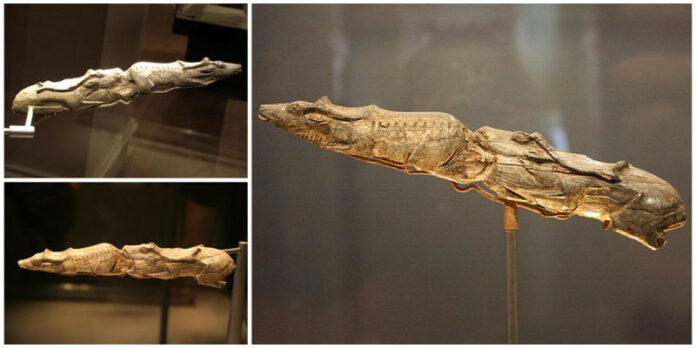Unveiling Ancient Artistry

In the realm of prehistoric art, few pieces capture the imagination quite like the “Swimming Reindeer.” This remarkable carving, dating back approximately 13,000 years, stands as a testament to the artistic prowess of our Ice Age ancestors. Discovered in 1866 near the French village of Bruniquel, this ancient masterpiece has since found its home in the British Museum’s prestigious Christy Collection.
A Serendipitous Discovery

The Swimming Reindeer’s journey from obscurity to fame is a tale of fortune and keen observation. Initially found in two separate pieces by French engineer Peccedeu de l’Isle, it wasn’t until 1904 that French archaeologist Abbé Henri Breuil recognized the fragments as parts of a single sculpture. This revelation unveiled a stunning depiction of a male and female reindeer, seemingly captured mid-migration.
Craftsmanship Beyond Its Time
Artistic Mastery in the Ice Age

Carved from a mammoth tusk using stone tools, the Swimming Reindeer showcases an extraordinary level of detail and polish. The sculpture portrays the animals with remarkable accuracy, their legs stretched backward and jaws upturned, creating a vivid impression of reindeer swimming across a river.
A Window into Prehistoric Life

More than just a beautiful object, the Swimming Reindeer offers invaluable insights into the lives of our ancestors. It reflects a deep understanding of animal behavior and a profound connection between humans and the natural world. Experts believe the piece was likely created during the fall migration season, a crucial time for Ice Age communities that relied heavily on reindeer for survival.
The Significance of Ice Age Art
Beyond Utility: Early Expressions of Spirituality

Unlike tools or weapons, the Swimming Reindeer appears to have no practical function. Instead, it represents a pure form of artistic expression, possibly hinting at early forms of spirituality among human communities. This piece, along with other Ice Age artworks like the 23,000-year-old Lespugue Venus that later inspired Pablo Picasso, demonstrates the profound impact of ancient art on human culture.
A Legacy of Creativity
The Swimming Reindeer stands alongside other significant Ice Age discoveries, such as the 12,500-year-old Mammoth Spear, in painting a rich picture of prehistoric life. These artifacts not only showcase the survival skills of our ancestors but also their capacity for beauty and symbolism.
Conclusion: A Timeless Treasure

As we marvel at the Swimming Reindeer today, we’re reminded of the enduring power of art to transcend time and connect us with our distant past. This 13,000-year-old masterpiece continues to captivate audiences, offering a unique glimpse into the artistic capabilities, daily lives, and perhaps even the spiritual beliefs of our Ice Age forebears. In its delicate curves and intricate details, we find not just a sculpture, but a bridge spanning millennia, linking us to the very dawn of human artistic expression.

